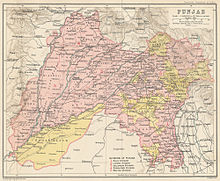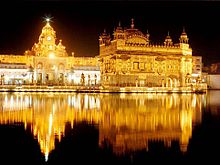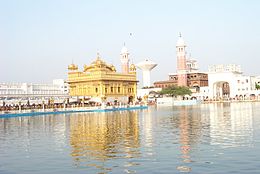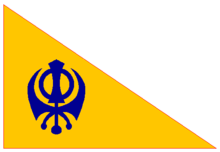- Outline of Sikhism
-
The following outline is presented as an overview of and topical guide to Sikhism:
Sikhism – monotheistic religion founded in the fifteenth century, upon the teachings of Guru Nanak Dev Ji and ten succeeding Gurus (the last one being the sacred text Guru Granth Sahib Ji), emphasizing universal, selfless love and brotherhood. "Only those who selflessly love everyone, they alone shall find God". It is the fifth-largest organized religion in the world[1] and one of the fastest-growing.[2]
Contents
Nature of Sikhism
Main article: SikhismThe khanda is the symbol of Sikhism. Sikhs have 5 different beliefs known as the Five Ks which they should keep with themselves at:
- Kesh (hair, God has given it to you to keep so why shave it)
- Kanga (a comb to keep all of your long hair up)
- Kirpan (a mini sword to defend yourself, some people have a necklace which has a mini kirpan on it)
- Kachera (plain white shorts)
- Kara (a metal bracelet which shows that god is immortal, never ending)
Sikh scripture
See also: :Category:Sikh scripture- Adi Granth
- Mool Mantra
- Bani - Gurbani
- Laava or Laavan - Wedding hymn or hymns.
- Sarbloh Granth
- Sawaya or Sawayya - One of the morning prayers.
- Sohila or Kirtan Sohila
- Tav-Prasad Savaiye
- Varan Bhai Gurdas
Sri Guru Granth Sahib
- Japji Sahib
- Shabad Hazaray
- Anand Sahib
- Rehras Sahib
- Kirtan Sohila
- Sukhmani Sahib
- Asa di Var or Asa di Vaar - A morning prayer.
Dasam Granth
Dasam Granth
Sikh religious philosophy
- Sikhism primary beliefs and principles
- Sikh Rehat Maryada – Sikh code of conduct, put into force right from the birth of Sikhism
- Guru Maneyo Granth
- Sikhism technique and methods
- Sikhism underlying values
- Prohibitions in Sikhism
Sikh beliefs
- Simran
- Sewa
- Three Pillars
- Naam Japo –
- Kirat Karni –
- Wand kay Shako –
- Five Evils –
- Five Virtues
Sikh practices
Main article: Sikh practicesSee also: :Category:Sikh practices- Sikh Rehat Maryada –
- Nanakshahi calendar –
- Aardas –
- Amrit – elixir of immortality - the sanctified nectar or sugar water substitute used in ceremonies. It is prepared by stirring it in an iron bowl with the double-edged sword and continuous recitation of five banis by the five selected members of the Khalsa.
- Amrit Sanchar, Amrit Sanskar – baptism (sanchar means ceremony)
- Anand Karaj – Sikh marriage ceremony, meaning "Blissful Union" or "Joyful Union". It was introduced by Guru Amar Das.
- Antam Sanskar –
- Chaṛdī Kalā –
- Daasvand, Dasvand, or Daswand
- Five Ks –
- Kachha/kachchhera – Short undergarments - one of the Five K's that a Khalsa Sikh must wear. It is a symbol of self control.
- Kanga – Comb - one of the Five K's that a Khalsa Sikh must west. It is a symbol of discipline.
- Kara – A loose steel bracelet - one of the Five K's that Sikhs must wear. It is a symbol of restraint.
- Kesh – Unshorn hair - one of the Five K's that Sikhs must wear.
- Kirpan – Short sword - one of the Five K's that a Khalsa Sikh must wear. It is a symbol of the fight against injustice and religious oppression.
- Jhatka karna (or jhatkaund) – instantaneous severing of the head of an animal with a single stroke of any weapon, to kill it with minimal suffering.
- Kirat Karni –
- Kirat Karō –
- Kirtan –
- Langar –
- Naam –
- Naam Karan –
- Nām Japō –
- Simran –
- Three Pillars of Sikhism –
- Vaṇḍ Chakkō –
- Wand Shakna – To share one's bounty with others (See daan.)
- Wand kay Shako –
- Selfless service (seva, sewa, or nishkam sewa) – One of the 2 foundations of Sikhism. Volunteer work; work offered to God. Three varieties of seva are sanctioned in the Sikh lore]] – that rendered through the corporal instrument (tan), that through the mental apparatus (man) and that through the material wherewithal (dhan). There are 4 types of Seva:
-
- Dhan di Seva – the form of seva people are most familiar with, doing seva by performing virtuous deeds and service
- Mann Di Seva – done by doing Simran, cleansing the Soul of polluted thoughts and Maya.
- Guru di Seva – by having your Mann attuned to his Nam
- Satgur ki Seva –
Sikh ceremonies
- Nam Karan - Child's naming ceremony
- Amrit Chhakna or Amrit Sanskar - Khalsa baptism ceremony
- Anand Karaj - Sikh wedding ceremony
- Antam Sanskar - Sikh funeral rites
Sikh geography
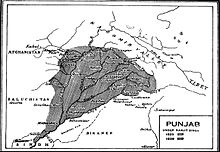 Map of Ranjit Singh's empire at its peak.
Map of Ranjit Singh's empire at its peak. See also: :Category:Sikh places
See also: :Category:Sikh places- Akal Takhat (Eternal Throne) - Nominal seat of Sikh spiritual authority.
- Amritsar – city of 1.5 million in the northwestern part of India. It is home to the Harmandir Sahib, known as the Golden Temple, the spiritual and cultural center of the Sikh religion.
- Anandpur or Anandpur Sahib –
- Nankana Sahib –
- Samadhi of Ranjit Singh –
- Harmandir Sahib - Holy shrine of the Sikhs in the holy city of Amritsar.
- Kartapur - Seat of Guru Nanak's first school.
- List of places named after Guru Gobind Singh –
Sikhism by country
- Sikhism in Australia
- Sikhism in Afghanistan
- Sikhs in Belgium
- Sikhism in Canada
- Sikhs in Fiji
- Sikhism in India
- Sikhism in New Zealand
- Sikhism in Pakistan
- Sikhism in Thailand
- Sikhism in the United Arab Emirates
- Sikhism in the United Kingdom
- Sikhism in the United States
Gurdwaras
Category:Gurdwaras
Main article: Gurdwara- Harimandir Sahib
Gurdwaras in India
Gurdwaras in Pakistan
- Gurdwaras in Pakistan
Gurdwaras in Hong Kong
Gurdwaras in Malaysia
Gurdwaras in Singapore
- Central Sikh Temple
- Gurdwara Sahib Silat Road
- Gurdwara Sri Guru Singh Sabha
- Gurdwara Sri Guru Nanak Satsang Sabha (Katong)
- Gurdwara Khalsa Dharmak Sabha
- Gurdwara Pardesi Khalsa Dharmak Diwan
- Gurdwara Sahib Yishun
Gurdwaras in Canada
Gurdwaras in the United States
- Sikh Gurdwara - San Jose
Sikh politics
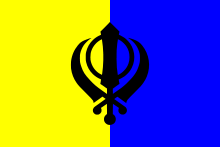 A proposed flag for Khalistan
A proposed flag for Khalistan See also: :Category:Sikh politics
See also: :Category:Sikh politics- Babbar Khalsa –
- Khalistan movement – Separatist movement [3][4] to create a Sikh homeland, often called Khālistān (Punjabi: ਖ਼ਾਲਿਸਤਾਨ, Hindi: ख़ालिस्तान "The Land of the Pure"), in the Punjab region of India and Pakistan[5][6]
- Punjab Janata Morcha –
- Sarb Hind Shiromani Akali Dal –
- Shiromani Akali Dal –
- Haryana State Akali Dal –
- Shiromani Akali Dal (Democratic) –
- Shiromani Akali Dal (Longowal) –
- Shiromani Akali Dal (Panthik) –
- Shiromani Akali Dal (Simranjit Singh Mann) –
- Shiromani Akali Dal Delhi –
History of Sikhism
Main article: History of SikhismSee also Category: History of Sikhism.- Sikh Confederacy –
- Sikh Empire –
- History of the Punjab
- Sukerchakia –
- First Anglo-Sikh War - 1845–1846
- Second Anglo-Sikh War - 1848–1849
- Battle of Saragarhi - Famous battle
- Amritsar Massacre (Jalianwalla Bagh Massacre) - April 13, 1919
- Operation Blue Star (Golden Temple Massacre) - June 1984
- Anti-Sikh riots - November 1984
Sikh culture
- Punjabi language
- Sikh Festivals
- Sikh names
- Turban
Sikh people
 Sikh man in turban
Sikh man in turban
- Sikhs - article focused on Sikh society
- List of Sikhs
- Amritdhari – baptized Sikh who has undergone the Khalsa ceremony. According to Sikh Reht Maryada, any person who is initiated into the Khalsa is called Amrit Dhari.
- Panj Pyare or Panj Piare (literally the five beloved ones) - title given to five Sikhs by Guru Gobind Singh at the historic divan at Anandpur Sahib on 30 March 1699 and who formed the nucleus of the Khalsa as the first batch to receive at his hands khanda di Pahul, i.e. rites of the two-edged sword.
Sikh Gurus
- Sikh Gurus –
- Guru Nanak Dev[7] (15 April 1469 – 22 September 1539) – founder of the religion of Sikhism and the first of the ten Sikh Gurus. The Sikhs believe that all subsequent Gurus possessed Guru Nanak’s divinity and religious authority.
- Guru Angad Dev (31 March 1504 – 28 March 1552) – disciple of Guru Nanak Dev and second of the ten Sikh Gurus.
- Guru Amar Das (5 May 1479 – 1 September 1574) – third of the ten Sikh Gurus, given the title on 26 March 1552 (at the age of 72).
- Guru Ram Das (24 September 1534[1] – 1 September 1581) – fourth of the ten Sikh Gurus, given the title on 30 August 1574.
- Guru Arjan Dev (15 April 1563 – 30 May 1606) – fifth of the ten Sikh Gurus, given the title on 1 September 1581. He was arrested and executed by Jahangir in 1606.[8]
- Guru Har Gobind (19 June 1595–2 March 1644) – son of Guru Arjan Dev and the sixth of the ten Sikh Gurus, given the title on 25 May 1606.
- Guru Har Rai (26 February 1630 – 6 October 1661) – grandson of Guru Har Gobind and seventh of the ten Sikh Gurus, given the title on 8 March 1644.
- Guru Har Krishan (7 July 1656 – 30 March 1664) – son of Guru Har Rai and eighth of the ten Sikh Gurus, given the title on 7 October 1661.
- Guru Tegh Bahadur (1 April 1621 – 11 November 1675) – grand uncle of Guru Har Krishan and ninth of the ten Sikh Gurus, given the title on 20 March 1665. He was executed on the orders of Mughal Emperor Aurangzeb in Delhi.[9]
- Guru Gobind Singh – son of Guru Tegh Bahadur and tenth of the ten Sikh Gurus, given the title on 1 November 1675 when he was only nine years old. He named a book as his successor...
- Guru Granth Sahib – the religious text of Sikhism, said to be the sole and final successor of the line of gurus,[10] the final and eternal guru of the Sikhs.[11]
Other esteemed Sikh individuals
See also: :Category:Sikh warriors and :Category:Sikh martyrs- Jassa Singh Ahluwalia –
- Baba Budha Ji –
- Baba Buddha - One of the most revered Sikh saints and anointer of several of the early Sikh Gurus.
- Banda Singh Bahadur –
- Sikh Bhagats
- Bhai Bala –
- Sri Chand - Guru Nanak's son and founder of an early Sikh sect.
- Bhai Gurdas - One of the most revered Sikh saints and writer of the Vars.
- Hazrat Mian Mir –
- Bhai Lalo –
- Bhai Mardana – Guru Nanak's constant Muslim companion, musician, and composer of sikh hymns.
- Giani Sant Singh Maskeen –
- Moti Ram Mehra –
- Bhai Kahn Singh Nabha –
- Nanki - Guru Nanak's sister and often considered his first disciple.
- H. S. Phoolka –
- Baba Gurdit Singh –
- Bhagat Puran Singh –
- Bhai Taru Singh –
- Bhai Vir Singh –
- Baba Deep Singh –
- G. B. Singh –
- Giani Gurdit Singh –
- Ishar Singh –
- Nand Singh –
- Nawab Kapur Singh –
- Randhir Singh –
- Ranjit Singh –
Sikh education
- Damdami Taksal
- Guru Nanak Dev University
- World Sikh University [1]
- Khalsa College London [2]
Sikh literature
Category:Sikh literature
- Janam Sakhi (non-canonical Sikh history)
-
- Bala Janamsakhi - A collection of janamsakhis by Bhai Bala (generally accepted as authoritative).
- Mani Singh Janamsakhi or Gyan ratanavali - A collection dating from the time of the last Guru.
- Miharban Janamsakhi - Janamsakhis written by the followers of Prithi Chand.
- Puratan Janamsakhi - An early collection of janamsakhis by an unknown author.
General concepts
- Bani – verses. An abbreviation of Gurbani, applied to any of the writings which appear in the Guru Granth Sahib.
- Bhagat Bani – Any of the writings which appear in the Guru Granth Sahib which were not written by the Gurus.
- Daan – Charity. One of the 3 petitions - Naam, Daan, Ishnan.
- Dasband (daswand) – 10% of earnings donated to the less advantaged.
- Dastar – Turban (Pugree). It is an inseparable part of Sikh dress and is mandatory for a Sikh to tie his turban according to Sri Guru Granth Sahib and the Sikh 'Code of Conduct'.
- Dharam di Kirat – to earn an honest living.
- Diet in Sikhism
- Diwali –
- Ek Onkar –
- Gatka – Sikh martial art
- Gurbani – Collective writings of the Sikh Gurus. (See bani.)
- Gurdwara, gurudwara – Place of worship, meaning "God's door", or God's place
- Gurmukh – Person who is spiritually centered. (See manmukh.) A person who lives within the will of God and accepts all good and bad that happens to ones self without question or annoyance.
- Gurmukhi – The written form of Punjabi used in the Sikh scriptures propagated by Guru Nanak and Guru Angad. Gurmukhi script is also called 'Paintis Akhri' because it contains thirty-five letters.
- Gutka – Prayerbook containing daily prayers.
- Harmandir Sahib –
- Hinduism –
- History of the Punjab
- Ik Onkar –
- Ishnan – Purity of mind and body. One of the three petitions - Naam, Daan, Ishnan.
- Islam
- Jap – Recite.
- Japji Sahib – The first 8 pages of the Siri Guru Granth Sahib (Sikh holy scripture), consisting of hymns composed by Guru Nanak.
- Jayadeva in Sikhism - Wrote two hymns that are in the guru granth.
- Jhatka – Meat of an animal which has been killed quickly with one stroke. Sikhs eat jhatka meat of any animal but cannot eat halal (kuttha) meat, where the animal has been slowly bled to death. This would also apply to kosher meat or any other animal sacrificed in the name of God.
- Kakke – Panj (5) K's that must be worn by Sikhs.
- Kaur – Princess. Female Sikh middle name or surname
- Khalsa – Pure - must carry panj kakkar
- Khalsa Panth –
- Khanda - A symbol of the Sikh faith (as well as being an Indian-double edged sword); also appearing on the Nishan Sahib which flies over gurdwaras.
- Kirat karō (kirat karni) – One of the three primary pillars of Sikhism, the others being Naam Japo and Wand kay Shako. The term means to earn an honest, pure and dedicated living.
- Kirtan –
- Kurahit kurahat – The cardinal sins for the Sikhs. These are cutting, trimming, shaving or removing hairs from one’s body, eating kuttha meat, using tobacco or any other intoxicant in any form or committing adultery.
- Kuttha – Meat killed in a sacrificial manner, such as Halal or Kosher.
- Laava –
- Manmukh – A self-centered person, contrast gurmukh. A person who lives within the will of the Mind as opposed to the will of god.
- Mela Maghi –
- Mul Mantra – Basic statement of creed.
- Naam – Name. Remembrance of the divine name.
- Nām Japō, Naam japna – Recitation and meditation on the Naam of the Lord.
- Nanakshahi calendar –
- Nirankari –
- Nitnem – Daily prayers which begin with Japji Sahib and are written in a Gutka (prayerbook).
- Panj dokh – The 5 thieves/betrayers. Ahankar (pride), Kam (lust), Krodh (anger), Lobh (greed) and Moh (worldly attachment)
- Panj Kakke – The Five K's; the five external symbols worn by both male and female Sikhs. The name of each symbol starts with the letter k (kakka); kaccha, kanga, kara, kesh and kirpan.
- Panj virtues – Daya (compassion), Nimrata (humility), Pyare (love), Santokh (contentment) and Sat (truth).
- Panj weapons – Chardi Kala (positive energy), Daan (charity), Dayan (kindness) Nimarta (humility), Santokh (contentment)
- Panj – The number 5
- Patit – Apostate
- Pugree – Dastar, turban. It is an inseparable part of Sikh dress and is mandatory for a Sikh to tie his turban according to Sri Guru Granth Sahib and the Sikh 'Code of Conduct'.
- Sangat – Society (congregation) see Panth.
- Sarbat da Bhalla – Welfare of mankind (sarbat = mankind, bhalla = welfare)
- Sarbloh Warriors - a computer game based around Sikh resistance against Mughal rule
- Sardar –
- Satguru –
- SGPC (Shiromani Gurudwara Prabhandak Committee) –
- Shabad, Śábda – The religious hymns contained in Sikh scriptures.
- Shaheed – Title used before the name of a person who has died as a Sikh martyr.
- Sikh –
- Sikh Bhagats –
- Sikh Empire –
- Sikh Light Infantry –
- Sikh Regiment –
- Simran – Simran is the remembrance of Waheguru. Guru Nanak formed a new type of Bakti beginning with Simran and Jap of Waheguru Gurmantar.
- Singh Sabha –
- Singh – Lion. Male Sikh middle or surname title.
- Sloka – Stanza. The Sanskrit epic metre formed of thirty-two syllables]] – verses of two lines (distich) of sixteen syllables each or in four half-lines (hemistich) of each syllables each. Japu (recitation) comprises an introductory sloka, 38 stanzas traditionally called pauris and a concluding sloka attributed by some to Guru Angad.
- Sukhmani – the Psalm of Peace.
- Takht
- Takhat –
- Tankhah – Salary, payment also social offense - He is not to commit any of the social offences (Tankhah), such as giving dowry, using liquors and intoxicants, raising monuments over graves and associating with apostates.
- Turban – Dastar (Pugree). It is an inseparable part of Sikh dress and is mandatory for a Sikh to tie his turban according to Sri Guru Granth Sahib and the Sikh 'Code of Conduct'.
- Udasis –
- Waheguru (ਵਾਹਗੁਰੂ) – Wonderful is the Lord.
Notes
See also
- Glossary of Sikhism (alphabetical)
- Interfaith dialog
References
- ^ Adherents.com. "Religions by adherents" (PHP). http://adherents.com/misc/rel_by_adh_CSM.html. Retrieved 2007-02-09.
- ^ "The List: The World's -Growing Religions". Foreign Policy. http://webcache.googleusercontent.com/search?q=cache:dE9WYJ_OAD8J:www.foreignpolicy.com/articles/2007/05/13/the_list_the_worlds_fastest_growing_religions+The+List:+The+World's+Fastest-Growing+Religions&cd=2&hl=en&ct=clnk&gl=us&client=opera. Retrieved 5 November 2010.
- ^ Colonist, Times (2008-03-11). "Sikh separatists in Canada concern Indian government". Canada.com. http://www.canada.com/victoriatimescolonist/news/story.html?id=40a84f84-80c5-4293-9d3f-aeff4040afe2. Retrieved 2010-01-22.
- ^ "25 years on, few takers for Khalistan in Canada". Thaindian.com. http://www.thaindian.com/newsportal/world-news/25-years-on-few-takers-for-khalistan-in-canada_100268207.html. Retrieved 2010-01-22.
- ^ The foreign policy of Pakistan: ethnic impacts on diplomacy, 1971-1994 ISBN 1-86064-169-5 - Mehtab Ali Shah “Such is the political, psychological and religious attachment of the Sikhs to that city that a Khalistan without Lahore would be like a Germany without Berlin.”
- ^ Amritsar to Lahore: a journey across the India-Pakistan border - Stephen Alter ISBN 0-8122-1743-8 “Ever since the separatist movement gathered force in the 1980s, Pakistan has sided with the Sikhs, even though the territorial ambitions of Khalistan include Lahore and sections of the Punjab on both sides of the border.”
- ^ Guru Nanak may be referred to by many other names and titles such as Baba Nanak or Nanak Shah.
- ^ N. Jayapalan (2001). History of India. Atlantic. p. 160. ISBN 9788171569281.
- ^ A Gateway to Sikhism | Sri Guru Tegh Bhadur Sahib J - A Gateway to Sikhism
- ^ Deol, Harnik (2000). Religion and Nationalism in India. Routledge. p. 62. ISBN 041520108X.
- ^ Keene, Michael (2003). Online Worksheets. Nelson Thornes. p. 38. ISBN 074877159X.
External links
- Sikh History Web Portal
- Sikh Philosophy Network An Online Sikh Discussion Forum
- The second scripture of Sikhism: Sri Dasam Granth Sahib
- Srigranth.org
- Sharing the Sikh experience
- Aboutsikhism.org
- Sikh-heritage.co.uk
- Allaboutsikhs.com
- sikhismguide.org, guide to the Sikh religion
- About Sikhs Informative Website on Sikh Faith, culture & religion
Outlines General reference · Culture and the arts · Geography and places · Health and fitness · History and events · Mathematics and logic · Natural and physical sciences · People and self · Philosophy and thinking · Religion and belief systems · Society and social sciences · Technology and applied sciencesCategories:- Sikhism
- Sikhism-related lists
- Outlines
Wikimedia Foundation. 2010.


